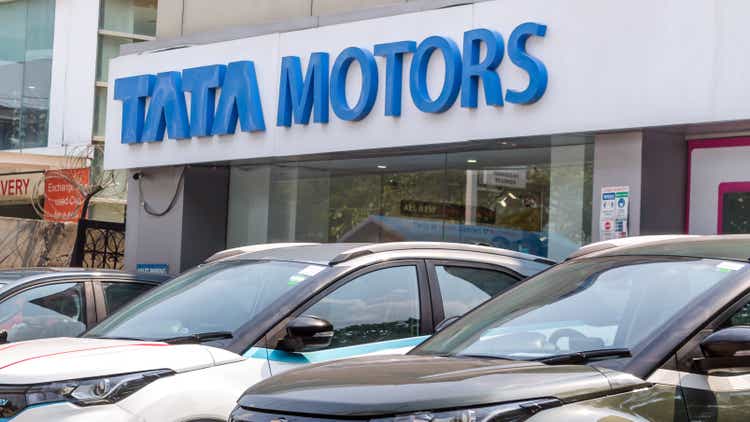Mrinal Pal
Elevator Pitch
I upgrade my investment rating for Tata Motors Limited’s (NYSE:TTM) [TTMT:IN] shares from a Hold to a Buy. Headwinds relating to commodity costs and chip shortages have receded; and the long-term outlook for TTM’s electric vehicle or EV business is good.
New Tata Tiago EV Was Well-Received By Consumers
On September 28, 2022, Tata Motors published a press release highlighting the planned introduction of the company’s first electric vehicle or EV hatchback known as the Tata Tiago EV.
This was a significant move for two key reasons. Firstly, hatchbacks are a key segment of the Indian vehicle market. Based on an August 18, 2022 Reuters article, hatchbacks boasted a 38% share of the vehicle market in India in 2021. Secondly, the penetration rate of electric vehicles in India is very low, with credit rating agency Fitch forecasting that electric vehicles will only represent 1.2% of total vehicle sales in India this year. As such, it is reasonable to assume that the Indian consumers’ response to the Tata Tiago EV offers an indication of whether India’s EV market has long-term growth potential and if TTM’s EV strategy is working well.
Tata Motors subsequently revealed on October 11, 2022 that the company secured more than 10,000 bookings for the Tata Tiago EV in the first 24 hours of the new vehicle’s official launch on October 10. The Hindustan Times also reported on October 10, 2022 that online bookings for the Tata Tiago EV sent “the official website crashing.” It is safe to say that Tata Motors’ new Tiago EV launch was a huge success, judging by its initial bookings.
Spotlight On The Growth Potential Of TTM’s EV Business
The Indian EV market has substantial potential for growth in the long run, and TTM is the dominant player in this segment.
According to an August 12, 2022 Ernst & Young research report titled “Electrifying Indian Mobility”, the number of four-wheeler EVs sold in the Indian market could potentially rise from as little as 11,680 units in 2021 to 101,650 units by 2027 which will translate into a penetration rate of 3.4%.
Another way to assess the future growth of electric vehicles in India is to analyze the current and future EV sales for Tata Motors. As it stands now, EVs contribute about 7.5% of TTM’s vehicle sales for the Indian market. But TTM has guided that it expects EVs to make up as much as a fifth of its vehicle sales in the next couple of years.
Also, while the Indian electric vehicle market is growing, competition is less of an issue for Tata Motors. TTM is the outright market leader in India’s EV market, boasting a 90% share based on vehicle sales for the first three quarters of 2022. Competitors don’t have the product range to compete with Tata Motors. For example, Tata Motors’ closest competitor, MG Motor, is only positioned in the SUV segment while TTM has already launched EVs in the hatchback (Tiago), sedan (Tigor), and SUV (Nexon) segments.
Headwinds Easing
I previously touched on Tata Motors’ near-term challenges in the form of “semiconductor supply issues and elevated commodity prices” with my prior September 24, 2021 write-up for the company. Headwinds for TTM in these key areas should be receding, based on a review of Tata Motors’ recent announcements and management comments.
Tata Motors’ passenger vehicle sales jumped by +33% YoY from 34,155 units in October 2021 to 45,423 units in October 2022. A November 2, 2022 Seeking Alpha News article made reference to a company statement that TTM’s October 2022 sales were affected to some extent by “a planned shutdown of the Pune plant for preventive maintenance and debottlenecking actions.” As such, it is encouraging to see that Tata Motors can deliver such strong sales growth despite the temporary closure of one of its production facilities. This suggests that supply chain headwinds are easing for Tata Motors, which bodes well for the company’s short-term revenue growth outlook.
Separately, TTM recently issued a media release on November 5, 2022 noting that it will be raising the average selling prices of its passenger vehicles by close to +1% beginning on November 7. In its media release, Tata Motors specifically highlighted that it “has been absorbing a significant portion of the increased costs” previously, and this recent price hike will enable it to “pass on some proportion” of the growth in expenses. At its earlier late-July 2022 investor call, TTM has revealed that it is “seeing signs of softening” in commodity prices. Therefore, Tata Motors’ profitability should improve in the quarters ahead, taking into account reduced cost pressures and price increases.
Bottom Line
I previously assigned a Hold rating to Tata Motors, as I was concerned about some of the short-term challenges that the company faced, such as the semiconductor chip shortage and rising commodity prices. TTM’s recent monthly sales data and price hike announcement imply that these headwinds are receding. Separately, Tata Motors’ growth prospects in the EV market are promising, especially after considering the good response to its latest EV launch. In view of these latest developments, I have raised my rating for TTM to a Buy.


Be the first to comment